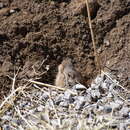en
names in breadcrumbs


This species is also known as Pappogeomys castanops in the literature.
Perception Channels: tactile ; chemical
This species is relatively common within it's range.
US Federal List: no special status
CITES: no special status
IUCN Red List of Threatened Species: least concern
Cratogeomys castanops is considered an agricultural pest because of it's burrows and the fact that it will eat the root systems of crop plants (Whitaker, 1997).
Negative Impacts: crop pest
Like other pocket gophers, Cratogeomys castanops is herbivorous. It will eat stalks and roots of many different plants, including stalks and joints of prickly pear. However, most foraging is done from underground. While foraging, C. castanops will store food in its cheek pouches. Most water is derived from the diet, so they drink very little water (Paradiso, 1975; Whitaker, 1997).
Plant Foods: leaves; roots and tubers; wood, bark, or stems
Primary Diet: herbivore (Folivore )
Southeastern Colorado and southwest Kansas, westernmost Oklahoma, to central San Luis Potosi (Mexico) (Wilson and Reeder, 1993)
Biogeographic Regions: nearctic (Native )
Cratogeomys castanops favors deep sandy or clayey soils for burrowing. Mounds of dirt excavated from burrows can often be found under bushes or cacti. When Pappogeomys is in a area that is also occupied by other species of pocket gopher (/Thomomys/ or Geomys) it tends to be restricted to shallower, rockier soils. It also appears to do better in drier habitats, with more desert plants (Davis and Schmidly, 1994; Paradiso, 1975; Whitaker, 1997).
Terrestrial Biomes: desert or dune ; savanna or grassland
Average lifespan
Sex: male
Status: wild: 2.6 years.
Average lifespan
Sex: female
Status: wild: 4.7 years.
The fur of Cratogeomys castanops varies from a light yellowish color to a reddish brown dorsally. The feet are dark. The tail has little or no hair. The length of the body is 226-320mm, and the tail length ranges from 70-105mm. Pappogeomys can be distinguished from other pocket gopher genera by the single groove on their incisors (Thomomys have no grooves on incisors; Geomys have two grooves on incisors.)
Range mass: 213 to 330 g.
Other Physical Features: endothermic ; homoiothermic; bilateral symmetry
Sexual Dimorphism: sexes alike
Cratogeomys castanops will often have multiple litters in a single year, and there are generally two young per litter. The sex ratio is skewed, with up to four times as many males as females. Mating begins in spring. Females will become reproductive in the year of their birth, but males will not mate until the following spring. (MacDonald, 1984; Paradiso, 1975).
Key Reproductive Features: gonochoric/gonochoristic/dioecious (sexes separate); sexual
The yellow-faced pocket gopher (Cratogeomys castanops) is a species of pocket gopher that is native to shortgrass prairies in the south-western United States and northern Mexico. It is the species that lives north of the Southern Coahuila Filter-Barrier (SCFB).[2] Among the different species, the yellow-faced pocket gopher has a small to medium-sized skull.[3] The fossil of this genus was recorded from the pre-Pleistocene Benson Beds of Arizona.[4]
The yellow-faced pocket gopher has a yellowish-brown coat, a short tail, and one deep groove down the anterior middle of each incisor.
Adults of C. castanops in Texas begin to molt in August and continue through March. The new pelage was found to be thicker, but had no change in color [5] In Kansas, semiannual molts in adults have been reported: 1. Molt from winter to summer early in the spring and 2. Molt in autumn in September and October [6]
There is sexual dimorphism in the yellow-faced pocket gophers; the males are larger than the females. The males of all genera of pocket gophers continue to grow after attaining sexual maturity, but females grow little after reaching sexual maturity.[7]
The reproductive activity of yellow-faced pocket gophers start in November and increases to a peak in March and/or April [8] During mating and copulation, the males emits low guttural squeaks throughout exploratory activities, then the male bites the female when body contact is made.[5] When young animals are old enough to leave the nest, they travel about maternal burrows. Then, when the young are nearly full grown, they disperse from the parental burrow.[9]
Researchers have seen a swimming ability in yellow-faced pocket gophers.[10] However, this genus of pocket gophers are less durable than other genera in water, perhaps because of the greater bulk (of its body) that inhibits its endurance.
Most of the foraging is done from the burrow system the yellow-faced pocket gophers create, pulling plants into the burrow by their roots.[9] The burrow system consists of tunnels dug by the gophers averaging 75.8m in length and 10 to 132 cm in depth.[11]
Yellow-faced pocket gophers usually inhabit deep sandy or silty soils that are relatively free from rocks.[9] However, where Geomys (another genus of pocket gophers) is present, Cratogeomys is restricted to "denser, shallower, sometimes rocket soils."[12][13] Research in Kansas showed that tracts that had no gophers occupying it consisted largely of areas with fine-textured soils that are planted with crops. The crops (corn, wheat, and grain sorghum) were harvested and disked annually along with the roadside ditches adjacent to the cropland. It was concluded that pocket gophers are not able to inhabit these lands because land-use practices have destabilized the habitats, eliminating both refuge and dispersal corridors.[14]
Yellow-faced pocket gophers are preyed on by small carnivorous mammals and large hawks and owls.[7][15]
There are currently 19 identified subspecies[16] of Cratogeomys castanops:
The yellow-faced pocket gopher (Cratogeomys castanops) is a species of pocket gopher that is native to shortgrass prairies in the south-western United States and northern Mexico. It is the species that lives north of the Southern Coahuila Filter-Barrier (SCFB). Among the different species, the yellow-faced pocket gopher has a small to medium-sized skull. The fossil of this genus was recorded from the pre-Pleistocene Benson Beds of Arizona.
The yellow-faced pocket gopher has a yellowish-brown coat, a short tail, and one deep groove down the anterior middle of each incisor.